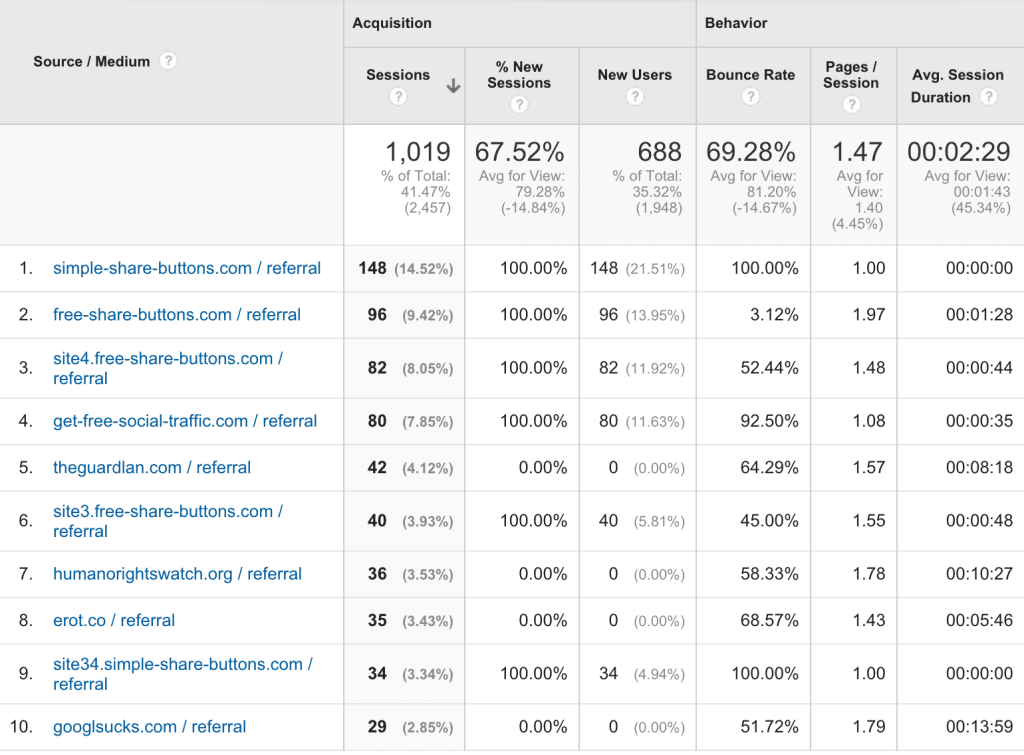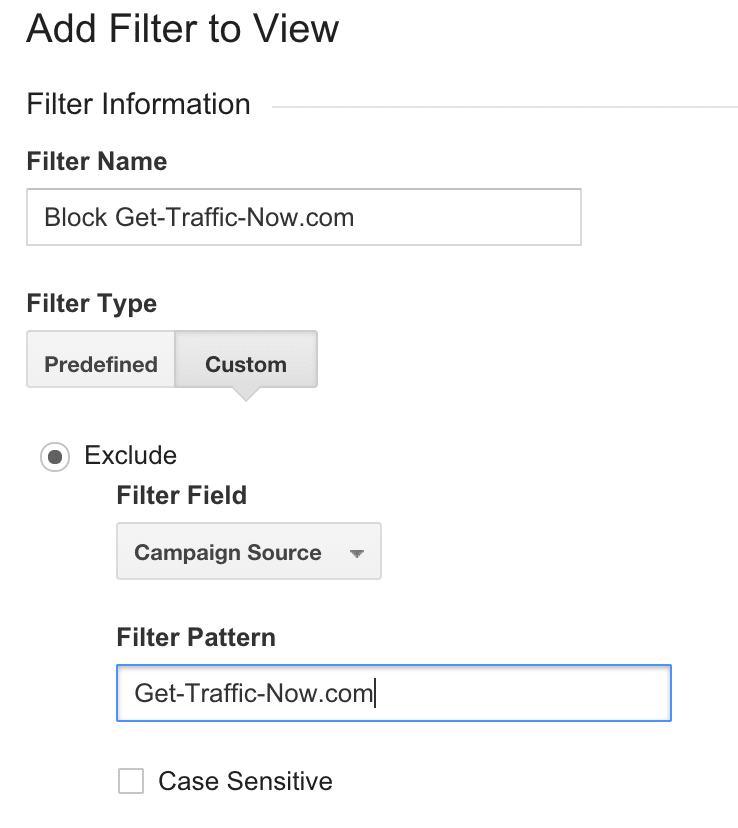Fighting Referral Spam in Google Analytics
[Jeremy Says: I’ve been struggling with GA referral spam for a few months and was hitting a creative wall. Fortunately others ran into the problem too and found a solution. I invited Jeff Siebach to tell you more about the problem and what he & his company came up with as a solution. Enjoy!]
Jeff Siebach says:
Over the last 6 months, you probably noticed a big increase in your reported referral traffic in Google Analytics. “Yes! I’m finally getting some visitors to my website!” you exclaimed happily.
Then you clicked to see where the traffic came from and your emotions changed from excitement to confusion. All of the traffic appears to be from ‘free-social-buttons.com’ and ‘Get-Traffic-Now.com’.
But why did those sites start sending you traffic, you ask?
That Referral Traffic Spike is Bogus
The answer is: they didn’t. What you’re seeing is a new form of spam that is sweeping Google Analytics accounts around the world. Referral spam, also known as “ghost referrals” is the newest way advertisers have found to promote their websites to website owners. This is particularly frustrating when you’ve been optimizing your conversion rates, and are understanding your lead attribution!
By faking traffic to your website, these spammers create mounds of referral traffic in your Analytics account in the hopes that you’ll see their website name and visit their site.
Here’s an example of what this may look like in your GA account:

So these bots are visiting my website?
Not exactly. When you add Google Analytics tracking code to your website, you use a unique “property ID” to tag your Google Analytics account that looks something like “UA-123456-78”. When visitors appear at your site, a small piece of javascript code sends Google a notification with that property ID to let them know that someone has viewed a particular page.
These bots crawl through the internet daily hunting down new property IDs that they haven’t found before. Then, once they’ve locked on to your ID number, they send notification after notification to Google stating that your page has been viewed.
They are not actually sending traffic to your website, just sending Google notifications that your website has been viewed and the source of the page view was (insert spam website here). Google can’t tell whether the page view actually happened on your domain or not – they just record the information they receive and report it back to you in your GA dashboard.
Well if they aren’t visiting my website, what’s the problem?
The unfortunate result of all of this spam is that your Google Analytics data is completely skewed because of all of the fake visits. These visits are often characterized by 0:00 time on site and a 100% bounce rate. They never convert on your conversion goals, reducing your conversion rate numbers, and they ramp up your referral traffic numbers, masking the important information you need to know about how people are getting to your site.
If your website has a lot of traffic, this may not be impacting you too greatly, only accounting for 5-10% of your traffic. But for most of us, who are working to drive traffic to a blog, or a new business, this spam may be responsible for 80% (or more!) of your reported visits.

Ok, now I’m mad! How do I get rid of Google Analytics Spam?
Blocking this traffic from appearing in your Google Analytics account can be done using GA filters. You can eliminate this traffic from your reports by using “Exclusion Filters” which can be found in the Admin -> Account -> Filters section of Google Analytics.
To block one of these sites, you’d create a filter with the following settings:

Save your filter, link it to the views that you want it to apply to, and voila! That site will no longer appear in your referral traffic moving forward. Now you can focus on other SEO efforts, like forecasting your potential traffic, fixing on-page seo issues, or building links.
One filter down, 200+ sites to go!
Blocking out all of the spam sites individually is a daunting task. Every day, new spam sites are being created and manually adding these filters is like an endless game of whack-a-mole.
No matter how thorough you are blocking all of the spam sites, new ones will appear the next day – and you may have ten or even hundreds of GA accounts you need to filter.
An automated solution
In order to combat this spam for good, we at Anchor Metrics created a tool called the GA Spam Fighter. We’re working with the team at SpamScape.net to maintain an up-to-the-day list of all of the known spam sites that have been plaguing Google Analytics. Then, we created a one-click solution to add filters to a GA profile that will block the entire list of sites at the same time.
To try it out, visit http://gaspamfighter.com.
First, you will be asked to link up your Google Analytics account and select the profile you want to filter. Click “Add Filters” and we will generate a handful of filters that exclude traffic from the newest list of spam websites (currently almost 300 domains long!).
These filters don’t remove traffic retroactively, but from that day forward these sites will no longer appear in your reports. [Jeremy Says: You’ll need some custom Segments for that]
A week later, when you’ve noticed some new spam sites appearing, make your way back to the GA Spam Fighter and run the filters again. We’ll automatically locate the original filters we made, identify any new spam sites that you aren’t blocking yet, and create another filter for the new sites.
Think of it like updating the anti-virus software on your computer.
Sounds great! How can I help?
If you’d like to help us maintain the software, head on over to SpamScape.net and anonymously link your Google Analytics profiles to their tool.
They’ll peek at your Analytics data daily to identify new spam sites and include them in the “blacklist”. Since the GA Spam Fighter pulls sites from that blacklist, you’ll be helping the tool keep up-to-date on the latest thing spammers are doing to ruin your day.
Together we can defeat these spammers once and for all.


